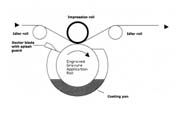
Your company is developing a new product based on a coated web of material, which has a specialty coating, or adhesive solution, applied to it. What coating application method should you choose? What are the drying or curing requirements of the adhesive or coating that will be applied? Choosing the right coating application method can be a difficult decision.
A number of coating methods are in use today, including direct gravure, reverse gravure, offset gravure, direct and reverse multiple roll configurations, calendaring, wire wound rod (also known as Meyer rod), knife-over-roll, curtain coating, air knife, slot die, and bar coating. These coating methods are broken down into two basic categories: pre-metered and post-metered coating methods.
Pre-metered methods apply a predetermined amount of coating to the web. Post-metered methods apply an excess amount of coating to the web, which is then metered off prior to drying or curing the coated web to obtain the desired amount of adhesive or coating solution on the web.
Pre-Metered Coating Methods
- All gravure methods
- Most multiple roll methods
- Curtain coating
- Slot die
- Calendaring
Post-Metered Coating Methods
- Wire rod
- Air knife
- Knife-over-roll
- Bar coating

The choice of coating application method is dependent on a number of factors. These include, but are not limited to: 1.) the viscosity and solids content of the coating solution; 2.) the actual coating weight or amount of adhesive or coating to be applied to the web of material and how often; and 3.) the surface profile of the material web to be coated. Often, a "coater-ready" adhesive or specialty coating solution will require some formulation modification of solids percent, viscosity, wettability or drying characteristics to optimize on-line coating performance.
For companies not involved in web coating on a daily basis, this can be confusing. They suddenly realize they have neither the expertise nor the capability to do the web coating part of a product development or product production project in-house.
It is usually at this point that many companies turn to an organization that can guide them through the myriad product development steps associated with web coating - a pilot coating company. One such company is ChemDevelopment Inc., part of the Chemsultants International Network.


It is for several of these reasons that two companies, GrafTech International Ltd. and International Test Solutions of Livermore, CA, specifically look to a pilot coating company like ChemDevelopment for their web coating needs.
GrafTech is a world-class manufacturer of natural graphite materials for use in fluid sealing, automotive and electronic thermal management applications. In recent years, it has developed a range of new graphite materials that are used as thermal interfaces and heat spreaders in electronic cooling applications. These materials take advantage of graphite's many unique properties, including high thermal conductivity and conformability.
GrafTech has worked with Chemsultants and ChemDevelopment in the development of many of these thermal interface and heat spreader products. GrafTech developed an advanced thermal interface material known as HiTherm® that incorporates a polymer addition to the graphite that lowers its thermal contact resistance. Chemsultants and ChemDevelopment were instrumental in developing a roll-coating production technique to add the polymer to the graphite material. Many of the thermal interface materials produced by GrafTech also require an adhesive layer to bond these materials to heat sinks and chips. The company turned to Chemsultants to help develop low thermal resistance adhesives capable of roll-coating application for these materials.

International Test Solutions (ITS) is a supplier of probe card cleaning materials for the testing of integrated circuits during the fabrication process on silicon wafers. The accurate validation of these circuits is crucial to the manufacturing process and has an enormous impact on the cost of production.
ITS products can increase the accuracy of testing and speed the production process through the use of patented cleaning polymers that remove debris from the electrical test probes. These probes are made of very fine filament wire and will collect debris from the wafer fabrication process over time, which alters the test signal received from the circuit. However, regular cleaning through touch-downs on the ITS cleaning pad ensures an accurate test connection.
Several years ago, ITS began supplying these novel polymer products using a single-sheet batch coating process that requires intensive manual labor. As the use of the product became more widespread in the integrated circuit manufacturing market, the volume demands grew tremendously, steering ITS toward a continuous process. However, the production of these materials has very specific requirements related to multilayer construction, zero tolerance for defects, and very accurate thickness control.
In order to meet these demands and keep up with volume requirements, ITS asked Chemsultants for assistance in developing a novel roll-coating production process suitable for the application.
ChemDevelopment was able to draw on extensive coating experience and internal machine engineering knowledge to develop a narrow roll-coating process that handles multi-later polymer products in a cleanroom environment. The coating machine and process also provide the flexibility to change over on short production runs and for a variety of set-ups for rapid development of new product constructions. The roll-coating process and coating environment are critical for the demanding requirements associated with materials used in the electronics industry, which far exceed the typical coated tape product.
Conclusion
The common thread in the success of both Graf-Tech and International Test Solutions - two customers with very different coated products and different roll coating solutions - was their ability to find the right coating application method (a roll applied method) through an outside consultant (Chemsultants) and a pilot coating company (ChemDevelopment).For more information on coating equipment, contact Chemsultants, 9349 Hamilton Drive, Mentor, OH 44060; phone (440) 352-0218; fax (440) 352-8572; or visit http://www.chemsultants.com .